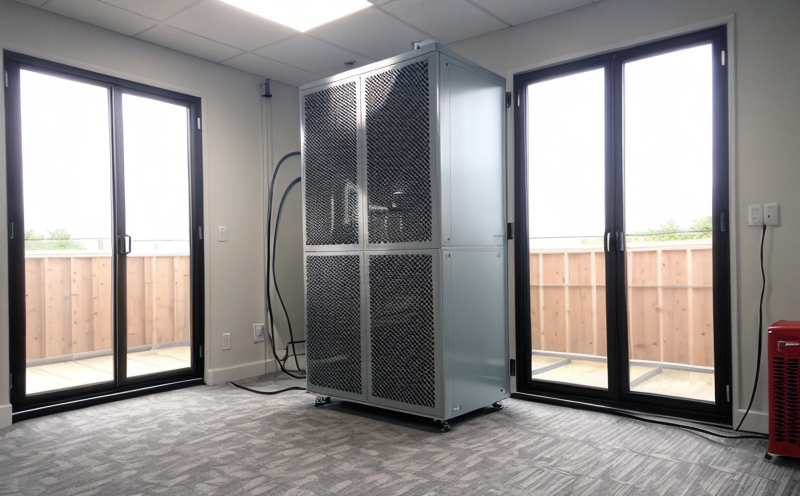Building Ventilation Flow Check
The Building Ventilation Flow Check is a critical service that ensures HVAC systems in commercial and residential buildings are operating efficiently. This service focuses on verifying that all ventilation ducts, grilles, and fans are delivering the required airflow as specified by design standards. Proper airflow is essential for maintaining air quality, energy efficiency, and comfort within indoor spaces.
The process involves a detailed inspection of the HVAC system to identify any blockages or inefficiencies in the ductwork that could affect ventilation performance. This service ensures compliance with relevant international standards such as ASHRAE 62.1-2019 for indoor air quality and ASHRAE 55-2017 for thermal environmental conditions.
During a Building Ventilation Flow Check, our team of experts uses advanced tools like anemometers, pressure gauges, and flow meters to measure the airflow at various points within the system. This data helps us assess whether the ventilation is meeting the expected levels as per the design specifications. Any discrepancies found are documented thoroughly, along with recommendations for corrective actions.
The importance of this service cannot be overstated. Poor ventilation can lead to numerous issues including mold growth, high energy consumption due to inefficient systems, and discomfort among occupants. By conducting regular Building Ventilation Flow Checks, facility managers and building owners can ensure optimal performance of their HVAC systems, thereby enhancing occupant health and satisfaction.
Our team not only performs these checks but also provides detailed reports that outline the findings and proposed solutions. These reports serve as valuable resources for decision-makers in maintaining and improving the indoor environment of buildings. Whether you are a quality manager looking to ensure compliance or an R&D engineer focusing on enhancing system efficiency, our Building Ventilation Flow Check service offers comprehensive insights into your HVAC operations.
Moreover, this service is particularly beneficial during periods of renovation or upgrade projects where changes in ductwork can impact airflow distribution. By addressing these issues early on, we prevent potential disruptions and ensure a smooth transition to improved ventilation standards. For procurement teams responsible for selecting new equipment or systems, our insights into current operational performance provide crucial data when evaluating bids.
In summary, the Building Ventilation Flow Check is more than just a routine inspection; it’s an essential part of ongoing maintenance that contributes significantly towards achieving sustainable and healthy indoor environments. With its focus on precision measurement and adherence to recognized standards, this service plays a vital role in sustaining optimal HVAC performance across diverse settings.
Scope and Methodology
The scope of the Building Ventilation Flow Check extends beyond mere inspection; it encompasses a comprehensive approach aimed at achieving precise airflow measurements. Our methodology involves several key steps designed to ensure accurate assessment:
- Initial Assessment: Before any testing begins, our team conducts an initial walkthrough and review of existing documentation related to the HVAC system.
- Data Collection: Utilizing specialized instruments like anemometers, pressure gauges, and flow meters, we collect detailed data points at multiple locations within the ventilation network.
- Analysis: Collected data is analyzed using industry-standard techniques to determine whether actual airflow matches expected values as defined by ASHRAE guidelines.
- Reporting: Results are compiled into a comprehensive report detailing findings alongside recommendations for necessary adjustments or replacements if required.
This structured approach guarantees that all aspects of ventilation performance are thoroughly evaluated, providing stakeholders with clear insights and actionable steps towards better management practices.
Benefits
The benefits of conducting Building Ventilation Flow Checks extend far beyond mere compliance requirements; they offer numerous advantages that contribute to overall building efficiency and occupant well-being:
- Enhanced Indoor Air Quality: By ensuring correct airflow, we minimize risks associated with poor air quality such as mold growth or stagnation.
- Energy Efficiency Improvement: Efficient ventilation reduces unnecessary heat loss/gain, leading to lower energy consumption and cost savings over time.
- Occupant Comfort: Properly ventilated spaces promote better thermal comfort for occupants, reducing complaints about overheating or cold spots.
- Potential Cost Savings: Early detection of issues prevents costly repairs down the line while also extending the lifespan of HVAC components.
- Safety Compliance: Adhering to strict ventilation standards helps avoid violations and associated penalties, ensuring continuous operation within legal boundaries.
- Data-Driven Decisions: Detailed reports provide valuable information for informed decision-making during maintenance planning or equipment replacement cycles.
- Increased Productivity: Comfortable working environments foster higher productivity levels among employees, contributing positively to business outcomes.
Incorporating regular Building Ventilation Flow Checks into your routine not only ensures regulatory compliance but also supports long-term sustainability goals by optimizing resource usage and enhancing living conditions. These benefits make it an indispensable component of any facility management strategy aimed at creating healthier and more efficient indoor environments.
Use Cases and Application Examples
The Building Ventilation Flow Check has diverse applications across various sectors, including commercial offices, educational institutions, healthcare facilities, retail stores, and residential complexes. Here are some specific use cases where this service proves particularly beneficial:
- Commercial Offices: Ensuring adequate ventilation helps maintain productivity levels while reducing health risks from poor air quality.
- Educational Institutions: Properly ventilated classrooms contribute to better learning environments and improved student performance.
- Healthcare Facilities: Maintaining stringent standards for airflow is crucial in preventing the spread of pathogens, ensuring patient safety.
- Retail Stores: Efficient ventilation can reduce operational costs by minimizing energy usage without compromising customer comfort.
- Residential Complexes: Regular checks help identify and rectify issues early, enhancing living conditions for residents and extending appliance lifespans.
In each of these scenarios, the Building Ventilation Flow Check serves as a proactive measure that supports continuous quality assurance efforts. It enables facilities managers to stay ahead of potential problems before they escalate into more significant challenges requiring extensive intervention.





